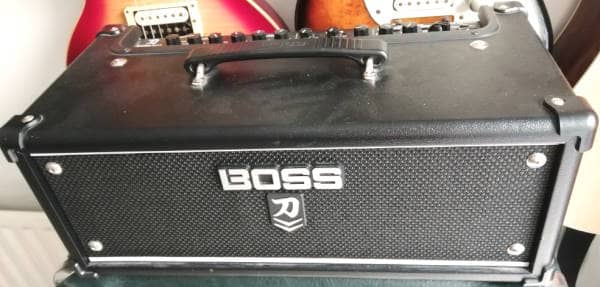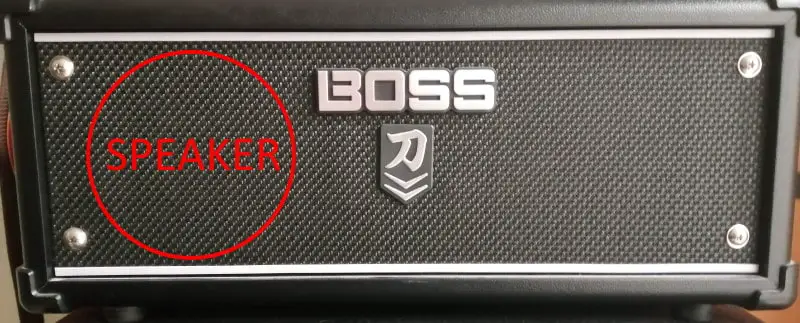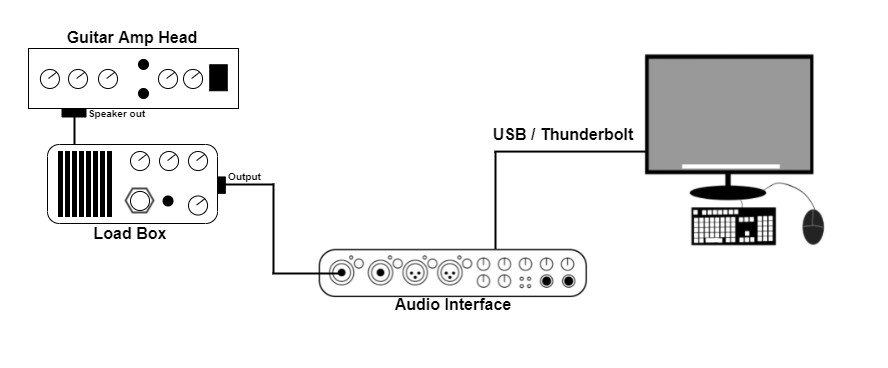All the guitar amps I have bought in the last few years have been separate amp heads. This is to benefit from the versatility that a separate amp head and speaker cab gives me. However, unlike a combo amp, an amp head makes no sound on its own.
As a general rule, you cannot play guitar through just an amp head. The head makes no sound on its own. In fact, using a tube amp head without a speaker connected is dangerous, and can seriously damage the amp. The head requires a load to distribute its power, usually provided by a speaker cabinet.
If you are unsure of exactly what an amp head, a speaker cab or a combo are, I highly recommend that you read my introductory article on the different types of guitar amps. This will give you the basic knowledge you need to use the different guitar amp setups.
Let’s begin with a quick reminder of the different types of guitar amp setups.

What are a guitar amp head and cab?
A guitar amp at a very simple level can be split up into 2 main parts…
- The amplifier circuitry that makes the signal louder and shapes the tone
- The speaker that turns the electrical signal into actual sound
These two parts can be both in the same physical unit (a “combo” amp), or as 2 separate units that you connect together using a speaker cable (separate “head” and “cab“).
In the separate head and cab setup…
- The Head: contains the amp circuitry, and has the controls for volume, gain, bass, treble, etc. on it
- The Cab: contains one or more speakers that output the actual sound
As a quick aside, if you have a Bluetooth speaker you may think you can connect your electric guitar to it instead of using an amp. I have a whole article dedicated to connecting electric guitars to Bluetooth speakers. Check it out to discover the different ways you can do this, the problems you may encounter and alternative methods for wireless guitar connections.
Back to amp heads. So, can you use a guitar amp head on its own?
You cannot play through just a guitar amp head
In general, you cannot play through just a guitar amp head. The amp head outputs no sound of its own. It outputs an electrical signal, and it is the job of one or more speakers to turn that signal into actual sound that our ears can hear.
So even if you play your guitar through just your amp head, you won’t be able to hear anything. Even more importantly, it can be dangerous to run your amp head without a connected speaker cab.
When it is dangerous to run an amp head on its own
It is actually dangerous for an all-tube (all-valve) amp head to be run without a speaker cab, or other suitable load connected.
The amp requires a load, as the power it generates needs to go somewhere. This load is usually provided by a speaker cabinet. When you don’t have that load, the output transformer in the amp head will overload, potentially seriously damaging it and the amp.
Solid-state amps should be ok to turn on without a connected load. The key is the amp’s power section. If it is all-tube (all-valve), then don’t run the head without an attached load. If it is solid-state, then you should be ok running the amp without an attached load. See the next section for circumstances when you might do this.
To be on the safe side, always check with the manufacturer or the user manual before switching on your amp head without a load attached.
This article is all about playing through an amp, an amp head in particular. But despite what you may think, you don’t necessarily need to play your electric guitar through an amp at all! Check out my “How to play electric guitar without an amp” article to learn about the different ways to play amp-less.
Exceptions where you can play through just an amp head
Although generally, you can’t play through just an amp head, there are a few exceptions where you can.
Boss Katana Head
I am very familiar with the Boss Katana Head, as I own the Mk II version. I’ll use it as an example, as it perfectly illustrates three ways that you can play through just an amp head, dependent on the particular make and model.
I think the Boss Katana Mk II Head is one of the most versatile affordable amp heads on the market. I have been using mine for home practice, band rehearsals and small gigs for several years, and has always given me stellar results. You can get the Boss Katana Mk II Head from Amazon (affiliate link) for a very competitive price.
Amp head with a built-in speaker

The Boss Katana Head actually has a small 5″ (12cm) speaker built into the head itself. This is intended for home practice. It is not loud enough to play gigs with, but is ideal to play through at home at low volume. Using this speaker, you can play through just the head on its own, without a speaker cabinet connected.
Using headphones
Some amp heads contain a headphone socket, including the Boss Katana Head. Plug in a set of headphones, and you can hear the amplified sound of your guitar, but no one else will. This is ideal for playing late at night, when you are trying to avoid waking the family/neighbors.
Using a speaker-emulated line-out
The line-out socket from the Katana Head can be connected to a PA system, so the sound of the amplified guitar can be heard without a speaker cabinet connected to the head. This signal could also be taken into your audio interface connected to your computer for recording.
With some amps, it is ok to use either headphones or the line-out socket without a speaker cabinet connected, as long as you keep the amp on standby. I believe the Blackstar HT-5RH is one of these.
As always, check with the manufacturer before taking any action that could potentially damage your amp.
Alternatives to a speaker cabinet for an amp head
If an amp head needs a load that is usually provided by a speaker cab, are there any alternatives to speaker cabs that can still provide the load?
Yes, there are; you can use something called a load box instead of the speaker cabinet.
A load box connects to the speaker out on your amp head, where you would normally connect the speaker cabinet. The load box provides a “load” that effectively absorbs the power coming from the amp head, just like a speaker cab does. This means you can safely run the amp head with a load box connected.

Load boxes do not have any speakers in them – they make no sound of their own. But they do have outputs that you can plug into something else to hear the sound e.g. headphones, an audio interface, a PA system etc. They are a great solution for recording your amp head without using a speaker cabinet, particularly if you want to record silently/quietly.
My recommendation for load boxes is the Torpedo Captor (affiliate link), available through Amazon at a competitive price. It is a simple plug-and-play option providing a load and speaker emulation. Each Torpedo Captor unit has a fixed impedance rating (e.g. 8 ohms, 16 ohms, etc). Make sure you get the one that matches your amp’s required speaker impedance.
There are actually several different methods for connecting your guitar amp to your computer. Check out my “How to connect your guitar amp to your computer” article for more information and comprehensive instructions.
Can you record with just an amp head?
As a general rule, you cannot record guitar using just an amp head as it makes no sound on its own. The traditional method of recording an amp head is to connect a speaker cab and place a microphone in front of one of the speakers. A load box can be used instead of a speaker cab for recording.
Having said that, there are a few exceptions. Using the Boss Katana Head as an example again, you could connect the line-out or headphone outputs to your audio interface for recording. This gives you a recording method using just the head if your amp possesses either of these outputs.
If your head has no line-out/headphone outputs, a load box could be used for recording without a speaker cabinet. Connect the load box output to your audio interface, and you will get a DI (Direct Input) signal of your amplified guitar sound.

A final alternative for recording electric guitar, is to not use amps at all. Software guitar amplifier simulators (“amp sims”) are good enough these days to give you a great recorded sound. For more details, I highly recommend you check out my article on recording guitar using amp sims.
On a related note, these days you can of course make use of amp sims to turn your computer into a guitar amp, removing the need for a traditional amp completely. My “How to use your PC as a guitar amp” guide gives you full instructions on the ways you can replace your amp with a computer.

